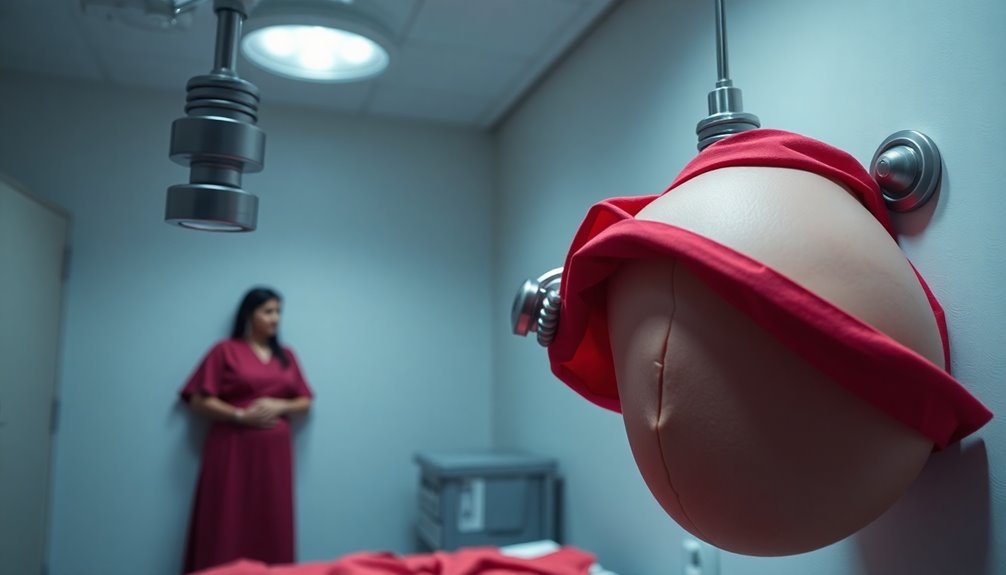Uterine rupture is a rare but serious complication that can occur during pregnancy or labor. If it happens, you might experience sudden severe abdominal pain and excessive bleeding, along with signs of fetal distress. Risk factors include previous cesarean births, uterine surgery, and larger babies. Quick diagnosis and emergency interventions are vital for survival. It is important to know the signs and manage your care effectively, so you'll want to discover more about prevention and management strategies.
Key Takeaways
- Uterine rupture is a rare but serious complication that can occur during pregnancy or labor, leading to severe risks for both mother and baby.
- Key symptoms include sudden severe abdominal pain, excessive vaginal bleeding, and abnormal fetal heart rate patterns indicating distress.
- Risk factors include previous cesarean deliveries, uterine surgery, multiple pregnancies, and labor induction methods.
- Immediate emergency C-section is crucial for management, ideally within 17 minutes of rupture onset, to ensure maternal and fetal survival.
- Consequences can involve severe hemorrhage, shock, and psychological trauma, emphasizing the need for preventive measures and close monitoring during labor.
What Is Uterine Rupture?

Uterine rupture is a vital condition that occurs when the uterus wall tears, most often along a scar from a previous cesarean delivery.
Uterine rupture is a critical condition characterized by the tearing of the uterus wall, typically along a cesarean scar.
This serious complication can be classified into complete rupture, which breaches all layers of the uterus, and incomplete rupture, which does not.
The incidence of uterine rupture after a prior cesarean is about 1 in 300 deliveries, but it rises to 9 in 300 for those with multiple cesareans.
Symptoms you may experience include severe abdominal pain, excessive vaginal bleeding, and signs of fetal distress, like abnormal heart rates.
Immediate surgical intervention is essential to minimize risks to both you and your baby, and severe cases might even necessitate a hysterectomy.
Who Is Most at Risk for Uterine Rupture?

If you've had a cesarean delivery in the past, you're at a higher risk for uterine rupture, especially during a vaginal birth after cesarean (VBAC).
Your history of uterine surgeries and any induced labor can also play a significant role in determining your risk.
It's essential to discuss your medical history with your healthcare provider to understand your specific situation.
Previous Cesarean Deliveries
Women with a history of cesarean deliveries face a markedly higher risk of uterine rupture during subsequent pregnancies. If you've had a previous cesarean delivery, your chances of experiencing this complication can increase, especially if you're considering a vaginal delivery after cesarean (VBAC).
| Factor | Risk Level |
|---|---|
| One Previous C-section | 1 in 300 deliveries |
| Multiple C-sections | Up to 9 in 300 |
| Low-transverse incision | Lower risk |
Uterine Surgery History
Having a history of uterine surgery, including cesarean deliveries, considerably raises your risk of uterine rupture in future pregnancies.
If you've had a previous cesarean, the likelihood of this complication can increase to about 1 in 300, and it rises even more with multiple cesareans.
Attempting a vaginal birth after cesarean (VBAC) adds further risk, especially if you have uterine scars or a history of multiple pregnancies, which can weaken the uterine wall.
Active labor is a critical time, as one-third of uterine ruptures occur before labor begins, but contractions can also cause the uterus to tear open.
Careful monitoring is essential during this time to address any risk factors for uterine rupture.
Induced Labor Risks
A history of uterine surgery, particularly cesarean deliveries, plays a significant role in determining the risks associated with induced labor.
If you've had multiple cesareans, your risk of uterine rupture can rise to 3.9%. Inducing labor with prostaglandin E agents increases this risk, so careful monitoring is essential.
When attempting a vaginal delivery after cesarean (VBAC), your chance of rupture is about 1 in 200, but it grows with each additional cesarean. Excessive uterine stimulation from oxytocin can also elevate the risk.
During induced labor, closely watch for fetal heart rate changes, as abnormalities may indicate potential rupture. Understanding these factors can help you make informed choices about your labor experience.
Warning Signs and Symptoms of Uterine Rupture

While uterine rupture is a rare complication, recognizing its warning signs and symptoms can be crucial for timely intervention. You should be alert for sudden severe abdominal pain and excessive vaginal bleeding, as these are key indicators.
Pay attention to fetal heart rate patterns; non-reassuring signs may suggest fetal distress. Additionally, if you notice slower or less intense uterine contractions, or a loss of uterine muscle tone, these could signal a problem.
Maternal shock can also occur, indicated by rapid heart rate and low blood pressure. Immediate medical intervention is critical because delivery time considerably affects survival rates, especially if a rupture occurs.
Responding quickly can make an essential difference for both you and your baby.
How Is Uterine Rupture Diagnosed?

How can healthcare providers quickly identify uterine rupture during labor? They rely on several key signs to make a swift diagnosis:
- Severe abdominal pain
- Excessive vaginal bleeding
- Abnormal fetal heart rate patterns (fetal distress)
- Inability to palpate the fetal head during a vaginal exam
- Cessation of uterine contractions
While ultrasound may reveal abnormalities, it's not always definitive.
Fetal heart rate monitoring is vital, as bradycardia often indicates uterine rupture.
If these signs present, healthcare providers must act immediately.
Timely diagnosis is essential to guarantee immediate surgical intervention, minimizing risks to both you and your baby.
Management and Treatment of Uterine Rupture

Recognizing uterine rupture requires immediate action to guarantee the safety of both mother and baby. The first step in management is an emergency C-section, ideally within 17 minutes of detecting fetal distress. Surgical intervention may involve repairing the uterus, but if there's severe blood loss, a hysterectomy might be necessary, impacting future fertility options. Blood transfusions are often required due to considerable maternal hemorrhage, with cases showing losses over 2,000 mL. Close monitoring for fetal distress, like abnormal heart rate patterns, is essential. Quick recognition and response considerably improve survival rates, as neonatal mortality ranges from 6% to 25%.
| Management Steps | Key Considerations |
|---|---|
| Emergency C-section | Timing is critical |
| Surgical intervention | Repair vs. hysterectomy |
| Blood transfusions | Prepare for major losses |
| Monitor fetal distress | Watch for heart rate changes |
| Quick recognition | Improves survival rates |
Complications Associated With Uterine Rupture

Uterine rupture can lead to serious complications for both mother and baby, making it a critical concern in obstetric care. Here are some potential complications you should be aware of:
Uterine rupture poses significant risks to both mother and baby, emphasizing the need for vigilant obstetric care.
- Severe bleeding, often exceeding 2,000 mL
- Maternal complications requiring hysterectomy in 6% to 23% of cases
- Increased risk of neonatal mortality, especially if rupture occurs before hospital arrival
- Higher incidence in women with multiple prior cesarean sections, up to 3.9%
- Possible need for blood transfusion and intensive care for the newborn
These complications highlight the urgent nature of uterine rupture, especially for those with an unscarred uterus, where the maternal mortality rate can reach 10%.
Awareness of these risk factors is essential for better outcomes.
Outlook for Future Pregnancies After Uterine Rupture

Experiencing a uterine rupture can greatly impact your future pregnancies. After a rupture, you're likely advised to opt for a scheduled cesarean delivery in subsequent pregnancies, as vaginal birth poses increased associated risks.
The risk of recurrent rupture ranges from 6% to 25%, making careful planning vital. Healthcare providers typically recommend a planned cesarean around 36-37 weeks to guarantee safety for both you and your baby.
Maternal mortality rates are considerably lower with a planned cesarean compared to attempting a vaginal delivery post-rupture.
It's important to have thorough discussions with your healthcare providers about your delivery options and the associated risks to navigate your future pregnancies safely and confidently.
Frequently Asked Questions
Is Uterine Tear the Same as Uterine Rupture?
Yes, a uterine tear and a uterine rupture refer to the same condition. It involves the wall of the uterus tearing, often due to a previous cesarean section.
You should know that this can lead to serious complications for both you and your baby. There are two types: complete and incomplete.
Recognizing the symptoms, like severe abdominal pain or unusual bleeding, is essential for timely medical intervention if it occurs during labor.
Can a Woman Survive an Uterine Rupture?
Can you imagine facing a life-threatening situation during childbirth? Yes, a woman can survive a uterine rupture, especially with quick medical intervention.
While the risk of maternal mortality is low at around 0.1% for those with a scarred uterus, every second counts when it comes to responding to fetal distress.
Recovery takes about four to six weeks, and it's vital to monitor for complications during this time for her health and well-being.
What Are the Findings of Uterine Rupture Assessment?
When evaluating for uterine rupture, you'll look for sudden severe abdominal pain, excessive vaginal bleeding, and signs of fetal distress, like abnormal heart rate patterns.
During labor, if you can't feel the fetal head during a vaginal exam and notice a decline in fetal heart rate, these are essential indicators.
What Is the Emergency for Uterine Rupture?
When the clock's ticking and every second counts, you need to act fast with uterine rupture.
This emergency requires immediate recognition of symptoms like severe abdominal pain and abnormal fetal heart rate.
You'll want to guarantee rapid cesarean delivery, ideally within 17 minutes of fetal distress.
Your quick response can make all the difference, improving outcomes for both you and your baby, so stay vigilant during labor and delivery.
Conclusion
In the grand tapestry of pregnancy, uterine rupture is a thread you don't want to ignore. By recognizing the risks and symptoms, you can safeguard your journey into motherhood. Just like a sudden storm can disrupt a calm sea, being proactive can help you navigate potential complications. If you've experienced a rupture, remember, you can still find hope for future pregnancies. Stay informed and consult your healthcare provider—your story isn't over yet, and brighter days are ahead.









